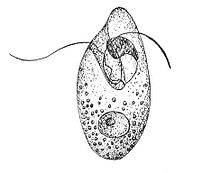Oxyrrhis marina
| Oxyrrhis marina | |
|---|---|
 |
|
| Scientific classification | |
| Domain: | Eukaryota |
| (unranked): | SAR |
| (unranked): | Alveolata |
| Phylum: | Dinoflagellata |
| Class: | Dinophyceae |
| Order: | Oxyrrhinales |
| Family: | Oxyrrhinaceae |
| Genus: | Oxyrrhis |
| Species: | O. marina |
| Binomial name | |
|
Oxyrrhis marina Dujardin, 1841 |
|
Oxyrrhis marina is a species of dinoflagellates with flagella. A marine heterotroph, it is found in much of the world.
This protozoan species has an asymmetrical oval shape to its single-celled body. It has been likened to a rugby ball. The cell usually measures between 20 and 30 micrometers, but it is known to reach 60. It has two flagella with a protruding, tentacle-like bulge between them. The flagella are covered in scales. Most individuals have scales on the body surface, as well. The two flagella have separate functions. One undulates in waves and the other is coiled, producing a corkscrew-like propulsion to move the cell. The individual appears colorless, but a concentrated culture of cells may have a pink tinge.
The species is thought to have a global distribution except for the polar seas, where it is likely absent or rare, though few samples have been taken of these waters. There are specific records from waters near Europe, North America, Asia, New Zealand, the Canary Islands,Hawaii, and the Azores. It has been found in isolated inland waters, as well, such as a lake in Ukraine. It is less common in the open waters of the oceans. There is a question as to how it came to inhabit so many islands if it is apparently rare in the open ocean. It may have been slowly dispersed on the currents, carried in mats of algae, or transported by humans when shipping arose.
It is most common in the intertidal zone and other coastal regions, where it is a member of the plankton. Habitat types include tide pools and estuaries. It was first described from a salt marsh. It tolerates wide ranges in salinity, temperature, and pH.
...
Wikipedia
